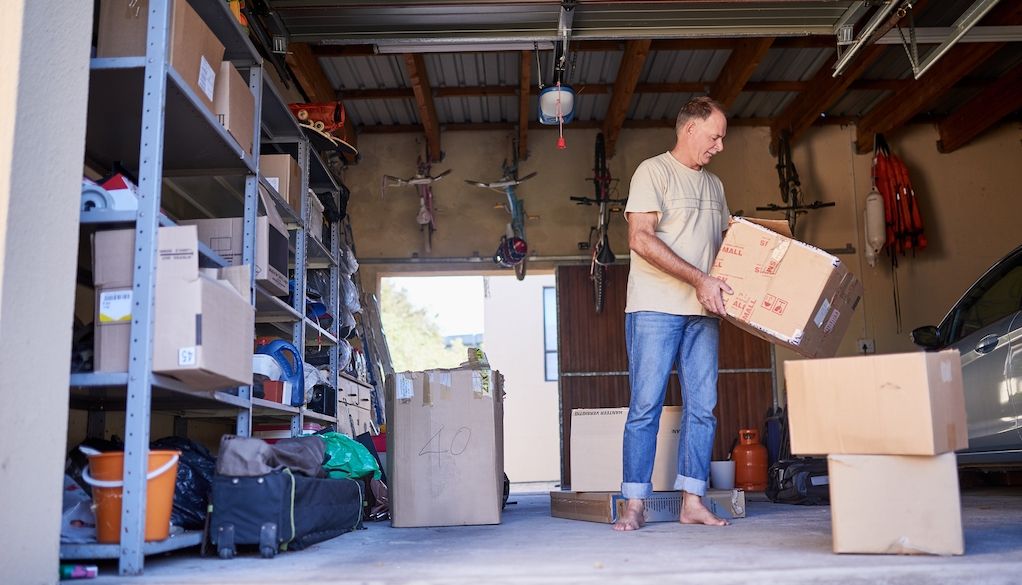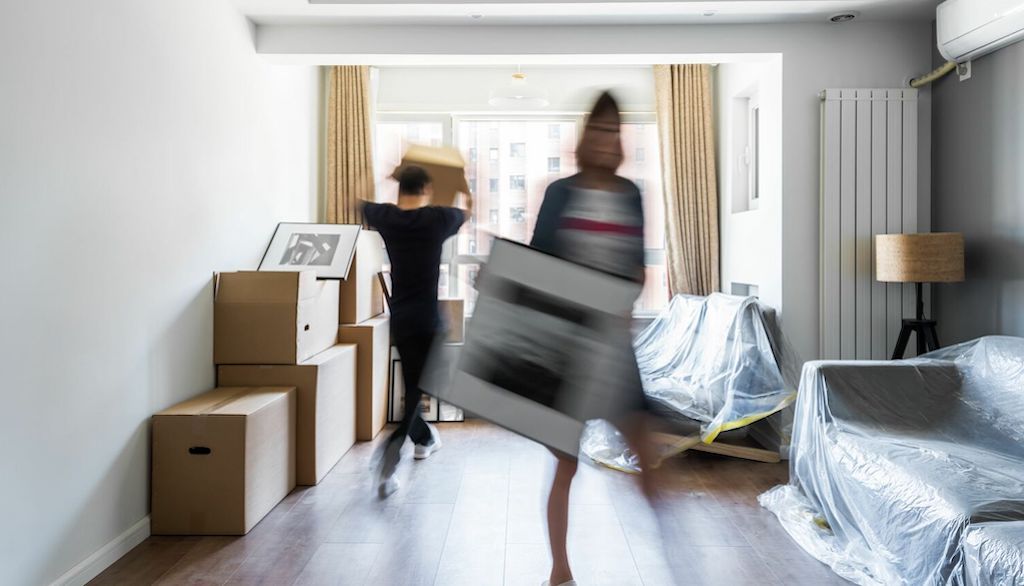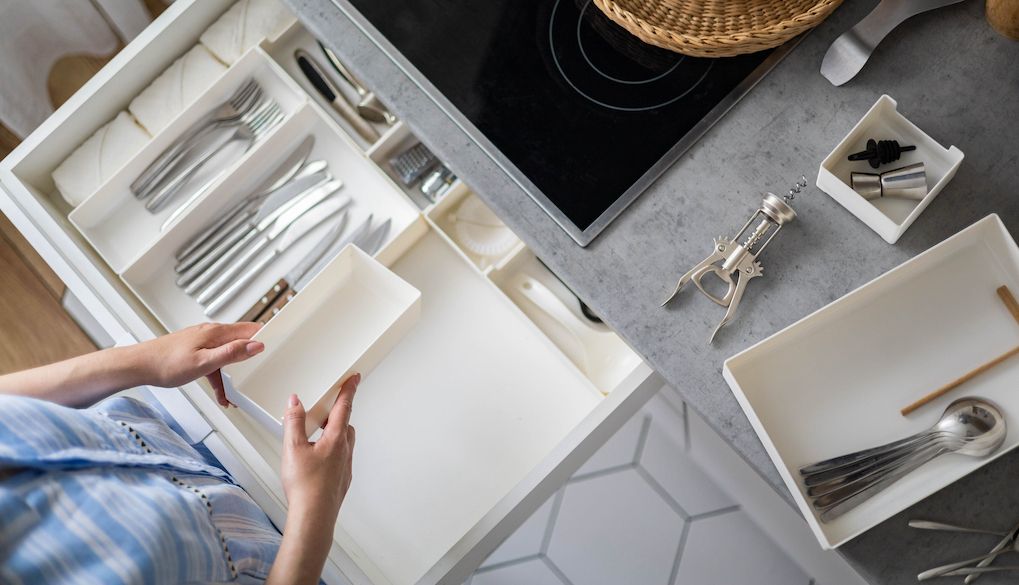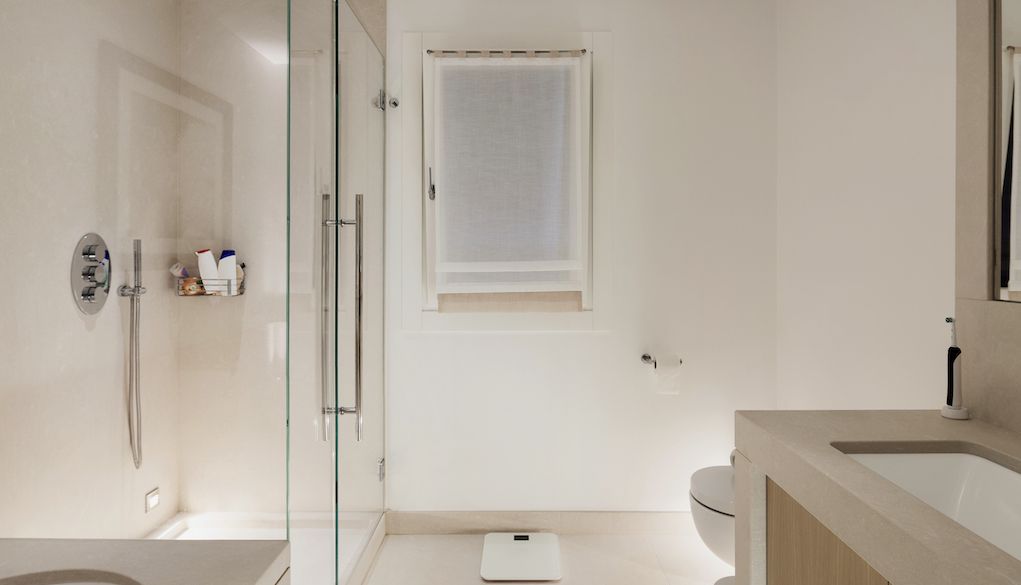Once you've done the research and settled on a moving company that fits your budget and meets your needs, it’s time to start planning the steps you'll need to take to pack up your life and move it to your new home. Moving to a new house or apartment is so much more involved than swaddling everything you own in bubble wrap and packing tape, then shoving it into a box so the movers can whisk it away to your new digs.
We've broken it all down for you. Here's everything you need to know about how to pack for a move.
Packing preparation to-do list.
Before you start tucking all your belongings away in boxes, it pays to sit down and write out a to-do list. There are many things to consider when preparing for a move, and having a list you can refer back to at a moment's notice is incredibly handy.
Organize your to-do list week by week. Next, pick up all the packing supplies you need:
- Moving boxes
- Packing tape
- Labels
- Markers for labeling
- Plastic bags
- Bubble wrap
- Scissors
- Blankets
When it comes to actually packing, keep things organized and write up an inventory for each room. Not only will you be able to keep track of everything, but having dedicated room inventories will help you plan how to pack.
Related: Where to get free (or cheap) moving boxes near you.
How far in advance should I start packing for a move?
Give yourself at least seven weeks or so to organize for a move. For bigger moves, eight weeks or more is ideal. Why so far in advance? Hear us out.
Your moving date will sneak up on you faster than you might think. Not only will you need to pack, but first you'll also need to go through your stuff and decide whether to declutter, donate or dump some of your belongings. You might need to tidy up your old place (potentially make repairs before the new owners move in), find a storage facility, buy replacement (or new) items for your new home and gather all of your packing supplies.
The bottom line: give yourself ample time to plan and pack for your move so it's as hassle-free as possible.
Garage packing checklist.
 The garage is a pretty good place to start when it comes to packing for a move. This is because the garage tends to be a place for storage, filled with items you don't use every day.
The garage is a pretty good place to start when it comes to packing for a move. This is because the garage tends to be a place for storage, filled with items you don't use every day.
Your first order of business should be to dispose of (or make an alternative plan for) any hazardous or toxic items, which moving companies probably won’t allow in the truck. This includes:
- Lighter fluid
- Weed killer, pesticides and other poisons
- Propane, kerosene and other fuels
- Acids and other corrosive liquids
- Paint and paint thinner
- Bleach, ammonia and other cleaning fluids
- Ammunition and weapons
- Anything flammable
- Anything explosive (like fireworks)
- Car batteries
Now, you can start packing up your garage. Take the following steps:
- Drain the fuel from the tanks attached to your lawn mowers or any equipment that runs on gas.
- Remove any attachments, especially sharp blades. Wrap and store them safely.
- Disassemble any power tools, wrap and store them in their original boxes if you still have them.
- Wrap tools and group them in boxes. Store hand tools, power tools, garden tools, etc. in separate boxes so it's easy to unpack on the other side.
- Clean and fold garden furniture. Use padding removed to make transport easier.
Living room packing checklist.
 No matter which room you start with, you should pack the items you use the least first. Here’s how to pack up your living room:
No matter which room you start with, you should pack the items you use the least first. Here’s how to pack up your living room:
- Wrap any large mirrors and other fragile items (glass vases, candle holders, picture frames, etc.) in blankets.
- If you happen to save the boxes you used for electronics (like TV, gaming consoles, stereo systems or desktop computers), repack them in their original boxes.
- Label wires and tape them to the back of the electronics they go with so you're not struggling trying to figure out which mystery wire goes with what once you're settling into the new place.
- Pack your books in smaller boxes. A large box stuffed with all your books will get heavy quickly.
- Take the cushions off any seats or couches. If needed, consider repairing or cleaning your upholstery before packing it up.
- Wipe, dust and clean down your coffee table, bookcases, shelves and end tables before you wrap and pack them up.
- Wrap your furniture, including sofas, chairs, tables and bookshelves in blankets to protect them during the move.
- Label each box with “Living Room” and add a short description of what’s inside the box.
Kitchen packing checklist.
 If you stick to your packing to-do list, you'll start packing your kitchen weeks before your moving date.
If you stick to your packing to-do list, you'll start packing your kitchen weeks before your moving date.
It's wise to plan ahead to make sure you don't pack up essential items before you turn over your keys. For example, keep enough cutlery, utensils, plates, bowls, and cups for you and your household. Or, buy enough plasticware to last you and your household several weeks. But you may want to also leave out a pot and pan so you can still cook.
- Wrap and pack pots, pans, baking trays, etc. into large boxes. You can stick pieces of cardboard between the layers so everything’s a little sturdier and won't bash around during the move. Or, you can buy several moving boxes that are specifically designed for these kitchen items.
- Wrap dishes and bowls in newspaper or bubble wrap. Tuck dish towels in any gaps in the boxes to help keep your china in place and to provide extra padding.
- Box kitchen utensils and cutlery together. Knives and sharp utensils should be well-wrapped in newspaper and stored sharp side down.
- Use the original boxes that your kitchen appliances arrived in when packing. If you didn’t, use similar-sized smaller boxes for smaller items like toasters, tea kettles and coffee machines.
- Big appliances should be cleaned out and emptied a few days before you move. Tape the doors shut, then wrap everything in large blankets so they don't get scratched or scuffed during the move.
- Once everything is in their boxes, add “Fragile” labels in permanent marker and mark each box with a “Kitchen” label too.
Bathroom packing checklist.
 Before you pack everything away, keep toiletry must-haves out like toothbrushes, toothpaste, medicine, soap and shampoo so you can still groom. Even better: pack up bulk- or large-size toiletries and just keep your travel-sized items out while you're packing up your home.
Before you pack everything away, keep toiletry must-haves out like toothbrushes, toothpaste, medicine, soap and shampoo so you can still groom. Even better: pack up bulk- or large-size toiletries and just keep your travel-sized items out while you're packing up your home.
- Wipe and wash your bathroom accessories to remove any soap scum and dirt that may be lurking.
- Use saran wrap on containers with liquid to prevent leaks during the move.
- Use bubble wrap to protect glass or ceramic items, such as toothbrush holders, small mirrors, soap dishes and dispensers, etc.
- Wash and dry towels, shower curtains and bathroom rugs and mats, then store them in a box. Make sure they're totally dry — you don't want to bring moldy towels into your new home.
Bedroom packing checklist.
 Bedrooms can be the last room on your moving checklist when it comes to the order in which you pack rooms. That said, you can still pack up quite a bit ahead of your moving day.
Bedrooms can be the last room on your moving checklist when it comes to the order in which you pack rooms. That said, you can still pack up quite a bit ahead of your moving day.
- Empty wardrobes, dressers, nightstands and other similar furniture. Tape doors and drawers shut so they stay secure in transit.
- All clothes should be clean and completely dry before the move.
- Mirrors should be wrapped in moving blankets.
- Group and pack clothing by season or by where you store it (ex: “summer wardrobe” or “dresser drawer clothes”).
- If you have garments on clothes hangers, you can cover them with a trash bag to protect them during the move.
- Tuck newspaper into your shoes and place them in storage containers or shoe boxes.
- Consider moving special jewelry and other sentimental items personally, rather than leaving this to a moving company. For example, place these items in your overnight bag or suitcase that will stay in your vehicle on move-in day.
Related: 15 tips, tricks and hacks for packing clothes when moving.
The best general packing tips from top-rated moving pros.
Whether it's your first big move or your fifth, there are a few golden rules notable moving pros recommend relying on to make moving day a breeze. These easy tips and tricks are great whether your new home is just across town or you're planning a long-distance move. From how to pack to simple organizational hacks, if you follow these general packing tips, you'll not only save money, you'll also make things easier for yourself when settling into your new home.
Tip #1: Purge first, pack later.
Don’t find yourself in your new place unpacking stuff you don’t even want. You’ll waste money buying more boxes, getting a bigger moving truck or paying the movers for longer hours.
Some professional organizers say you should start sorting through your stuff up to two months before your move. So, get rid of things you never wear. Say goodbye to furniture that doesn’t suit your new place. And give things away (or contact a pro to haul it away) and start fresh. Remember: those dresser drawers need to be emptied before the move.
Tip #2: Pack it yourself (unless it’s fragile).
If you’re hiring movers, you can ask them to pack everything as an add-on service. But most things are easier and cheaper to pack yourself. This way, you’ll know where everything is and you can make extra sure you’re only bringing things you want. Plus, some movers charge by the hour, so your overall tab will be lower if everything’s packed and ready to go when they get there.
But here’s a possible exception: if it’s likely to break (fragile items like glassware and dishes), consider letting a pro pack it. Even the slightest extra space in the box can lead to broken dishes if the truck hits a bump in the road.
That said, it’s a good idea to pack these items yourself if you want to keep track of valuables like family china, heirlooms and expensive jewelry. If you don’t have packing paper or bubble wrap, paper towels and newspapers make good wrapping material in a pinch.
Tip #3: Put heavy items in small boxes.
Yeah, you can use a dolly, but when you’re packing, imagine that you actually have to carry each individual box. You would be surprised how many people think, “Oh, I’ll just dump everything from this bookcase into this huge box. It’s so convenient.” But then the mover gets there and wonders exactly how you thought that 70-pound box was going to get off the floor and onto the truck.
Don’t be that person. Put your books in small boxes and your lightweight stuff like clothes and linens in large boxes.
Tip #4: Label your boxes by room and use a color-coding system.
A lot of people will label their boxes by what’s in them — not where they belong. But that won’t make the unpacking process easier, whether or not you’re hiring a moving company. Instead, plan to organize boxes room by room.
“Don’t label the box ‘clothing,’" says Jack Bornstein, owner of Texas Move It in Houston, Texas. “Label it ‘master bedroom closet.’ It makes it much easier for the movers when they get to the new place because they know exactly where it should go.”
You can even number the rooms in your new home to make it easier for the movers to know where to put things.
Tip #5: Keep your cables straight.
You disconnected all the entertainment cables — the TV, the stereo receiver, the gaming PC. But don’t confuse those cables with the charger for your handheld vacuum or the connector cable for your external hard drive.
Take this simple advice from Tyler Ancheta of Goal Line Moving in Minnesota: “Label the cords and where they go to before the movers take it apart, or take a picture.”
Ancheta adds that movers can take your TV off the wall, but they likely won’t remove the mount from the wall itself for liability reasons. So, you might need a handyman to help with that.
Related: 30 moving tips for an easier, stress-free transition.
Common packing mistakes to avoid.
By this point, you've probably gathered there's a right way and a wrong way to pack. We've covered the basic packing tips you should use when organizing a move. Now it's time to dive into the things you shouldn't do.
There are several common packing mistakes that anyone can fall prey to — you may even be guilty of a few during past moves and learned your lesson the hard way (we've all been there). Before you even touch a moving box, familiarize yourself with these common packing mistakes so you can avoid them.
Mistake #1: Underestimating how much stuff you have.
Almost everyone does this. It wastes time and costs extra money, whether you’re renting a truck or having a professional move you. Multiple trips to the store for boxes. Paying the movers to wait for you to finish packing because you’re not done when they get there. Finding out at the worst possible time that your stuff doesn’t fit in the truck size you reserved.
Avoid all of these issues by packing early — including sorting through donations and junk — and asking your moving company to come do a site inspection.
Mistake #2: Not packing an overnight bag with essentials.
Oops. You packed stuff you need right away like towels, pet food, toothbrushes, meds, important documents — even toilet paper — all in different places. Now you have to dig through all the boxes in every room to figure out where they even are. Too bad you didn’t pack an overnight (or weekend) bag with your must-haves. Ancheta says this is especially important for an out-of-town move where movers might not unload you until the next day. But it’s a good idea for any move, even a few miles away.
Mistake #3: Hiring a generalist to move specialty items.
Your piano is very nice. It would be a shame if it got damaged. Ditto for those expensive or oversized art pieces. You’ll have to get those crated up. And your pool table. You can’t play pool on a crooked table.
If you have specialty items in your home, make sure to get movers with the right expertise (pool table movers, piano movers, hot tub movers, etc.), equipment and experience to pack and move them safely. It may or may not be your general moving company. Do your research so you can make sure your specialty items get to your new home without a hitch.
Mistake #4: Skimping on cardboard boxes (and packing tape).
Remember: you have to pack absolutely everything in boxes. This means you need to get enough packing materials. Some moving supply stores will even buy back extra boxes that you don’t end up using (make sure to check). If that’s the case, there’s no downside to stocking up.
Take an inventory at home of roughly how many boxes you need and what sizes. It can’t hurt to have a range of packing supplies. Expect to put lighter items like linens and clothes in big boxes, and heavier things like dishes and books in smaller ones.
How much does it cost to hire packing services?
A lot of movers charge per hour per crew member. You might pay more depending on how much stuff you need to move, how far the movers need to drive and whether or not you want help with extras.
In general, the bigger the place and the heavier the items you need moved, the higher the moving cost. Extras like packing, furniture disassembly and supplies — like bubble wrap, packing paper and boxes — can add to the tab.
You’ll also have to factor in complications like flights of stairs, which mean harder work and extra care not to damage anything. But some moving companies may only charge on the way up, not the way down. Even if you’ll be using an elevator, not stairs, your moving company might add an elevator fee since it can slow things down. Tricky parking can also cost extra. Any parking scenario that isn’t right at your front door could mean a long-carry fee.
The best way to get started — and avoid surprises — is to get an in-home estimate. For more on costs, see our guide “How much do movers cost?” and contact a few professional movers for quotes before you hire a mover.